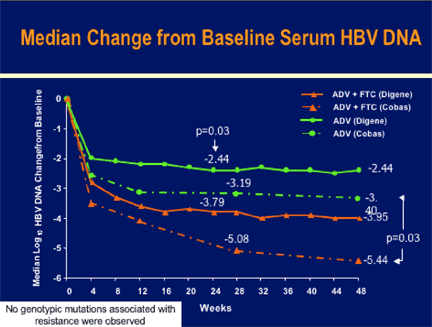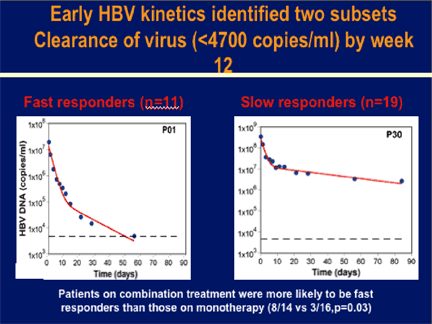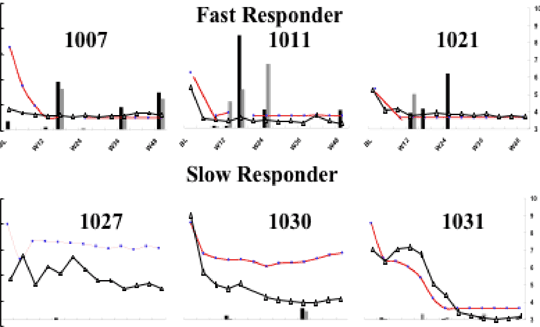 |
 |
 |
| |
Adefovir + FTC for HBV in HBeAG+: combination therapy for HBV
|
| |
| |
Reported by Jules Levin
"Randomized, Double-Blind Study Comparing Adefovir Dipivoxil (ADV) Plus Emtricitabine (FTC) Combination Therapy Versus ADV Alone in HBeAg (+) Chronic Hepatitis B: Efficacy and Mechanisms of Treatment Response"
George Lau reported in an oral talk the results from this combination therapy study at AASLD today, the last day of the conference Nov 2. Lau found combination therapy demonstrated greater antiviral activity using ADV+FTC than monotherapy using ADV (-5.44 log vs -3.40 log using Roche PCR, with lower limit of detection of 200 copies/ml). Different patterns of virus=specific reactivity have been identified during treatment with combination therapy leading to faster viral response. Lau concluded that assessment of early virologic response and T-cell reactivity may provide a basis for individualized approach and optimization of mono or combination therapies in chronic HBV.
This AASLD meeting was dominated by HBV. There were numerous studies presented for HBV drugs. Three large phase III studies were reported for entecavir in HBAg+, HBeAg-, and entecavir treatment in lamivudine resistant patients. Studies of additional HBV drugs in earlier stages of development were also presented. You can read reports so far compiled on the NATAP website at http://www.natap.org in the AASLD Conference Report section. New reports will be filed.
Thirty treatment naïve, HBeAg (+) patients (HBV genotype B - 9; genotype C - 21) with ALT> 1.3xULN were randomized to receive ADV 10 mg + FTC 200 mg qd (Group A, n=14) or ADV 10 mg + placebo qd (Group B, n=16) for 48 weeks. Blood samples were collected at Day 0, 1, 3, 5, 7, 9, 11, 14; Week 3, 4, 8, 12, 16, 20, 24, 28, 32, 36, 40, 44 and 48.
Lau provided this introduction. A short-term viral dynamic study of LAM+famciclovir suggested an advantage for combination therapy. Longer term studies have not consistently shown greater virologic response with combination treatment in patients with chronic HBV: LdT+LAM versus LdT; ADV+LAM versus LAM. Additive anti-HBV activity has been demonstrated in vitro for adefovir plus emtricitabine (FTC). FTCB-201 is an investigator-initiated pilot phase 2 study of ADV+FTC versus ADV monotherapy for 96 weeks. FTC is currently approved only for HIV infection. Adefovir dipivoxil (ADV) is an approved nucleotide only for chronic HBV.
The study aims are to compare the efficacy of a new combination therapy of ADV plus FTC in 14 patients versus ADV alone in 16 patients and to examine early HBV kinetics and virus-specific T-cell reactivity to gain understanding of the mechanisms of successful HBV control. Both FTC + ADV are taken once daily. Viral kinetics by mathematical modeling are performed by Dr. Alan Perelson, Los Alamos, NM. Viral load testing HBV DNA done by Digene Hybrid Capture II, LOD 4700 copies/mL and Roche Amplicor Cobas HBV PCR, LOD 200 copies/mL.
Patients are nucleos(t)ide treatment-naïve; have HBeAg+ chronic hepatitis B ; with serum HBV DNA > 0.7 MegaEq/mL; ALT > 1.3 times to 10 times upper limit; have compensated liver disease; no co-infection with HCV, HDV, or HIV; no treatment with IFN within 6 months.
Median HBV DNA was 7.6 log copies/ml in ADV+FTC arm & 8.5 log copies/ml in the ADV arm. 29% & 31% genotype B in ADV+FTC & ADV arms, respectively. 71% & 69% genotype C in ADV+FTC & ADV arms. Other baseline characteristics are comparable between arms: 100% Asian; 60% male; median ALT 2.1-2.4 x ULN.
RESULTS
MEDIAN CHANGE FROM BASELINE HBV DNA
ADV+FTC: -3.95 log (Digene, LLD 4700 copies); -5.44 (Cobas, LLD 200 copies)
ADV: -2.44 log (Digene); -3.40 (Cobas)
HBeAg seroconversion occurred in 3 patients - 2 in the combination arm & 1 in ADV group.
80% of (HBeAG+) patients had undetectable HBV DNA taking ADV+FTC vs 20% taking ADV and median log HBV DNA change from baseline was -3.55.
|
|
| |
| |
 |
|
| |
| |
Lau provided historical changes in HBV DNA for ADV from other studies, although you are not supposed to compare across studies.
CHARACTERISTICS FTCB-201 FTCB-301 437
| N=30 | n=104 | n=171 | | Male | 60% | 64% | 76% | | Median age | 40 | 37 | 32 | | Asian % | 100% | 67% | 60% | | Median ALT | 102 | 81 | 95 | | Median HBV DNA Log copies/ml | 8.41 | 8.23 | 8.4 |
In study 437, patients were taking ADV and 30% of patients had undetectable HBV DNA & decline from baseline in HBV DNA was about -3.55 log using the Roche Amplicor PCR, LOD 400 copies/ml.
In B301 study FTC 200 mg showed median -3.00 log decline in HBV DNA from baseline. In study B102 FTC log decline was also -3.00, compared to -4.00 log in the ADV+FTC study (using the same Digene test with cutoff of 4700 copies/ml. In studies B301 & B102 FTC showed 40% of patients had undetectable HBV DNA (Digene Hybrid Capture II; LOD 4700 copies/ml) compared to 80% in the combination study.
Virus-specific T cell studies
Serial PBMC prospectively collected: Wk 0, 2, 4 and then every 4 wks till wk 96
HBV-specific T-cell responses
Frequency of CD4+ T cells
ELISPOT assay
Frequency of CD8+ T cells
ELISPOT assay
Intracellular cytokine staining (ICS) -- 6 HLA A2 epitopes
Tetramers for Core and Surface epitopes
direct ex vivo
in vitro expansion
Frequency of NKT cells
Modeling of early HBV kinetics (baseline to TW12) revealed a 2-phase decay in most patients with the 1st phase t1/2 from 0.5 day to 3.3 days (mean: 1.4 ± 0.7 day) and the 2nd phase t1/2 from 3.6 to 112 days (mean: 24.4 ± 22.6 days).
The infected cell loss rate (δ) was significantly higher in the combination arm (δ =0.07 day-1) vs monotherapy (δ =0.04 day-1 p=0.04). Early HBV kinetics identified two subsets - patients who cleared the virus (<300 copies/mL) by TW12 (fast responders) and those who did not (slow responders). Fast responders had a larger δ (0.07 day-1) than slow responders (δ =0.03 day-1, p=0.006). Patients on combination treatment were more likely to be fast responders than those on monotherapy (11/14 vs 5/16,p=0.01). A fast response was associated with enhanced T-cell reactivity (for T-cell response to HBcAg p=0.05; and to HBsAg p=0.03). All 3 cases with HBeAg seroconversion were fast responders. No mutations or safety concerns were observed.
COMPARISON BETWEEN FAST vs SLOW RESPONDERS
| Fast Resp | Slow resp | | | N=11 | n=19 | | | Baseline Median ALT | | | | | X ULN | 2.1 | 2.9 | NS | | Median HBV DNA Log copies/ml | 7.27 | 8.50 | NS | | HBV Genotype C | 7 | 14 | NS | | Combination therapy | 8 | 6 | 0.0487 | | DURING 48 WKS THERAPY | | | | | HBV-specific CD4 IFN-γ + | 9 | 7 | 0.026 | | HBV-specific CD8 IFN-γ | 1 | 0 | NS | | HBeAg seroconvers | 2 | 1 | NS |
|
|
| |
| |
 |
|
| |
| |
|
|
| |
| |
 |
|
| |
| |
|
| |
|
 |
 |
|
|